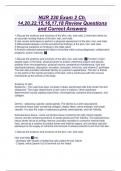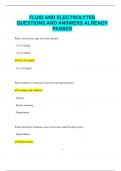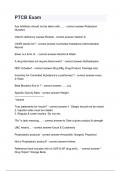NUR 230 Exam 2 Ch.
14,20,22,15,16,17,18 Review Questions
and Correct Answers
1.Discuss the anatomy and functions of the skin, hair, and nails. 2.Interview clients for
an accurate nursing history of the skin, hair, and nails.
3.Use correct techniques to perform a physical assessment of the skin, hair, and nails.
4.Differentiate between normal and abnormal findings of the skin, hair, and nails.
5.Recognize variations on findings in the older adult.
6.Analyze collected assessment data to formulate valid nursing diagnoses, collaborative
problems, and/or referrals. ✅
1.Discuss the anatomy and functions of the skin, hair, and nails. ✅Function of skin;
largest organ of the body, physical barrier to protect underlying organs and tissues,
protects from microorganisms, physical trauma, temperature maintenance, fluid and
electrolyte balance, absorption, excretion, sensation, immunity, and vitamin D synthesis.
The skin also provides individual identity to a person's appearance. The skin is thicker
on the palms of the hands and soles of the feet, and is continuous with the mucous
membranes at the orifices of the body.
Anatomy of skin;
Epidermis - The outermost layer consists of dead, keratinized cells that render the skin
waterproof. The major determinant of skin color is melanin. Other significant
determinants include capillary blood flow, chromophores (carotene and lycopene), and
collagen.
Dermis - sebaceous glands, sweat glands, The dermis is a well-vascularized,
connective tissue layer containing collagen, elastic fibers, nerve endings, and lymph
vessels. It is also the origin of sebaceous glands, sweat glands, and hair follicles.
Subcutaneous tissue - loose connective tissue containing fat cells, blood vessels,
nerves, and the remaining portions of sweat glands and hair follicles, The subcutaneous
tissue stores fat as an energy reserve, provides insulation to conserve internal body
heat, serves as a cushion to protect bones and internal organs, and contains vascular
pathways for the supply of nutrients and removal of waste products to and from the skin.
1.Discuss the anatomy and functions of the skin, hair, and nails.
Hair and Nails ✅Hair
- develops with sheath of epidermal cells called the hair follicle
- 2 types; vellus (peach fuz) & terminal (on the head)
,- color varies determined by melanin & pheomelanin
- filters dust and airborne debris
(nasal, auditory, eyelashes, eyebrows)
Nails
- keratinized epidermal cells
- pink tinge a result of blood vessels
- Lunula; crescent shape at the base
- protect distal areas of fingers/toes
- enhance precise movement/grip
2.Interview clients for an accurate nursing history of the skin, hair, and nails.
✅Subjective data collection order;
- History of present concern
- Personal Health History
- Family Health History
- Lifestyle and health practices
History of present concern;
rashes, lesions, dryness, oily, bruising, swelling, skin color, moles, birthmarks, pain,
itch, numb, tingle, new meds, odor, excessive perspiration, hair loss, nail condition
Personal Health History;
sunburns, current/previous problems, hospitalization (HAI's), surgery, allergic reactions,
recent viral/bacterial infections, pregnancy, self injury
Family Health History;
recent illness, rash, skin conditions
-skin cancer, keloids (tends to be familial)
- keloids; abnormal overgrowth/healing of skin
Lifestyle & Health Practices
-sun exposure, indoor tanning, self-exams, chemical exposure, sedentary/immobility,
temp changes, piercing/tattoos, skin care/hair care/nail care, use of lotions, makeup,
nutrition, smoking, alcohol use
3.Use correct techniques to perform a physical assessment of the skin, hair, and nails.
SKIN ✅When preparing to examine the skin, hair, and nails, remember these key
points: Inspect skin color, temperature, moisture, texture. Check skin integrity. Be alert
for skin lesions. Evaluate hair condition; loss or unusual growth. Note nail bed condition
and capillary refill.
SKIN
Inspection;
- color + variations
, - integrity
- odors
> pressure points/bony prominences
> Braden Scale
- look for lesions
(note size, location, symmetry, color, distribution)
- if inspecting a fungus, shine a Wood Light
(the lesion should not fluoresce)
Palpation;
- texture
(use the middle 3 fingers)
- thickness
- moisture, temperature, mobility
(use dorsal surface of hands to palpate temperature)
- Mobility and Turgor
> pinch skin over clavicle while pt laying
(should rebound quickly)
- Edema
lupus erythematosus ✅butterfly rash
3.Use correct techniques to perform a physical assessment of the skin, hair, and nails.
HAIR ✅- inspect scalp and hair for condition
- palpate the hair and scalp for cleanliness, dryness or oiliness, parasites, and lesions
- Inspect amount and distribution of scalp, body, axillae, and pubic hair.
3.Use correct techniques to perform a physical assessment of the skin, hair, and nails.
NAILS ✅- grooming and cleanliness
- nail color / markings
- shape
(is clubbing present? convex contour?)
- uniform thickness
- capillary refill
(pink tones return >2 sec after blanching)
- texture
- firm/immobile
(nails are attached firmly)
4.Differentiate between normal and abnormal findings of the skin, hair, and nails.
SKIN ✅SKIN
Pallor -






